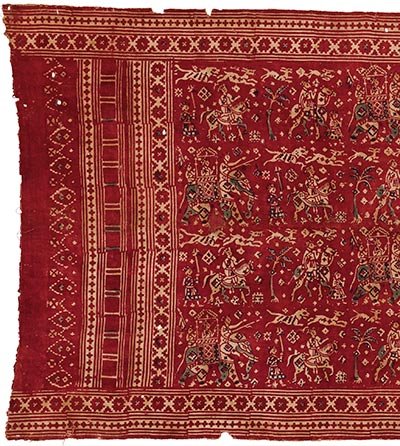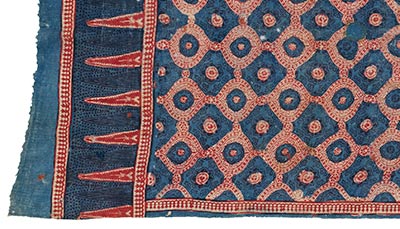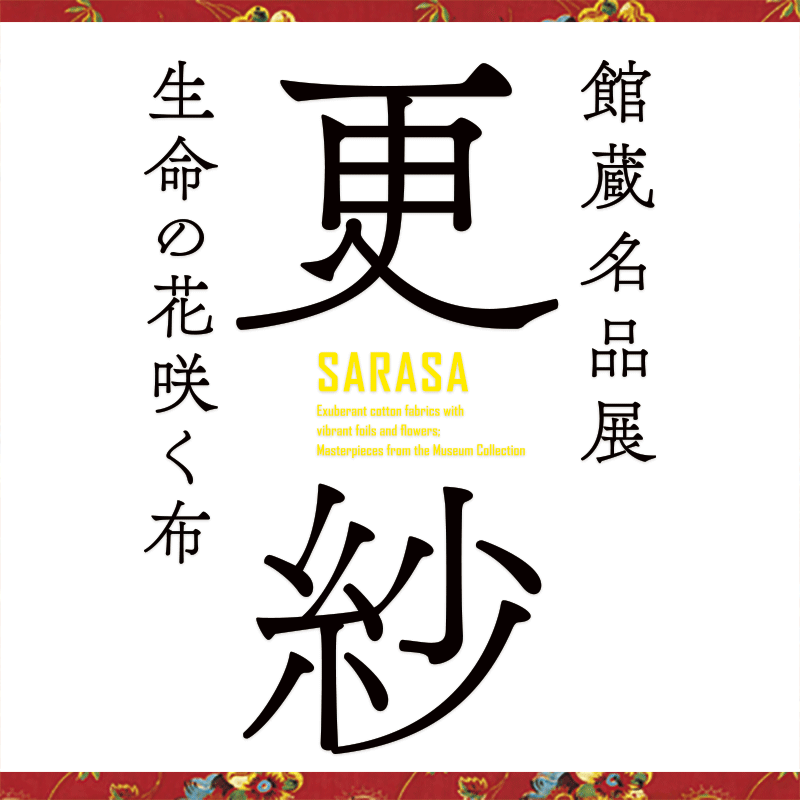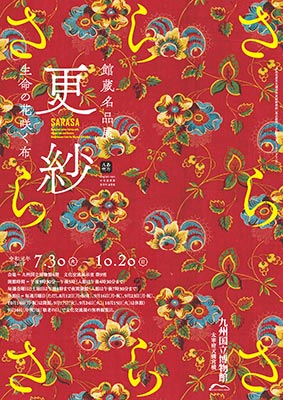Sarasa-Exuberant cotton fabrics with vibrant foils and flowers; Masterpieces from the Museum Collection
Exhibition period:
July 30 (Tue) – October 20, 2019 (Sun)
* Changes of exhibits will be carried out during the exhibition period.
Location:
Cultural Exchange Exhibition, Hall 9
Summary:
Sarasa, or chintz, refers to pattern-dyed cotton fabrics that originated in India. These Indian
mordant-dyed and resist-dyed cotton products in vivid madder and deep indigo are noted for the vivacity
and vigor. These cotton products must have fascinated anyone who took the fabrics in their hands. Sarasa
is well-loved and used not only in India, but also all over the world such as Southeast Asia, Persia,
Europe, and Japan. Sarasa was exported in a variety of motifs and colours, which inspired new designs
for foreign markets. Sarasa rode the waves of cultural exchange during the Age of Exploration and have
been transmitted as an essential item today.
This feature exhibition highlights masterpieces of sarasa fabrics that the Museum has actively been
collecting. We hope that you will explore the process in which Indian sarasa was first exported to many
parts of the world and then locally produced in many different regions. Enjoy the mesmerizing world of
this wondrous textile to your heart’s content!
Exhibition Layout and Main Exhibits
Part 1: It All Started In India
The tradition of producing pattern-dyed fabrics in India has a very long history. These beautiful, dyed textiles were already known to ancient Romans by the beginning of the Common Era. The textiles were exported very early on. During 16th to 17th century, they were known as “sarassa” or “saraça”. In Japan, they came to be known as “sarasa”.

Hanging cloth for temple, design of Krishna stories, sarasa with gold embellishment
Coromandel Coast, India; 18th century
Exhibition period: July 30 – September 8, 2019

Ceremonial cloth, design of ladies on an indigo ground
Gujarat, India / Sulawesi, Indonesia; 15th – 16th century
Exhibition period: September 10 – October 20, 2019
Part 2: Sacred Sarasa Fabric Handed Down As Family Heirloom
This section introduces Indian sarasa inherited among the Toraja, an ethnic group indigenous to Sulawesi, a mountainous island in Indonesia. The Toraja highly treasure their own hand-made dyed textiles as well as imported Indian sarasa fabrics, and use them in sacred rituals.


Ceremonial cloth, design of hunting on a madder ground
Gujarat, India/Sulawesi, Indonesia; 18th century
Exhibition period: July 30 – September 8, 2019


Ceremonial cloth, design of linked medallions and geometric-flower patterns on an indigo ground
Gujarat, India/Sulawesi, Indonesia; 16th – 17th century
Exhibition period: September 10 – October 20, 2019
Part 3: Various Designs From Different Cultures That Crossed The
Seas
Indian sarasa became widely exported to all parts of the world during the Age of Exploration. A wide variety of these textiles were created to meet the demands of different markets. The sarasa design introduced in this section are fabrics intended for Indonesia, Siam (Thailand), and Europe, but some designs were widely popular regardless of the regions.

Palampore, design of a standing-tree design with flower-and-tree on a white ground
Coromandel Coast, India/Sulawesi, Indonesia; 18th – 19th century
Exhibition period: July 30 – September 8, 2019

Ceremonial cloth, design of landscape with pine trees and cranes on a madder ground
Coromandel Coast, India/Lampung, Sumatra, Indonesia; 17th – 18th century
Exhibition period: September 10 – October 20, 2019
Part 4: Sarasa That Fascinated Japanese People In The Edo Period
Indian sarasa was exported to Japan in the latter half of 16th century. They were made as kosode (old-style kimono) which became extremely popular. Sarasa was also used to wrap boxes containing tea ceremony utensils. However, when roller printing and chemical dyes were invented in Europe in the 19th century, European sarasa with even brighter colours was created. As a result, these fabrics replaced a majority of Indian sarasa imports.

Kake-fukusa, square cloth with a design of arabesque flower on a red ground
Europe; end of 19th century
Exhibition period: July 30 – September 8, 2019

Tea-utensil mat, design of lion and arabesque on a madder ground (one part)
Woven and dyed in India; outer: 18th century, lining: 17th – early 18th
century
Tailored in Japan; 19th – 20th century
Exhibition period: September 10 – October 20, 2019
Part 5: Batik, A Blooming Sarasa Culture In Java
Indonesian batik (Java sarasa) has diverse patterns. Traditional Javanese patterns were combined with foreign designs, creating an original pattern. In Sumatra, a zigzag pattern along the edges of batik is preferred. This pattern was introduced to Indonesia through Indian sarasa, showing a deep relationship between both countries.

Sarung, skirt-cloth, design of flower-and-bird on a ground dyed in red and green with gold embellishment
Dyed in north coast of Java, Indonesia; embellished with gold in Sumatra, Indonesia
Early 20th century
Exhibition period: July 30 – September 8, 2019
出品リスト
| Title | Place of Production | Place of Used | Date/Century | Materials | Exhibition Period |
|---|---|---|---|---|---|
| Hanging cloth for temple, design of Krishna stories, sarasa with gold embellishment | Coromandel Coast, India | Coromandel Coast, India | 18th century | cotton | 7/30 - 9/8 |
| Hanging cloth, scene of South Indian court life on a white ground | Coromandel Coast, India | Sulawesi, Indonesia | 18th-19th century | cotton | 9/10 - 10/20 |
| Ceremonial cloth, design of Ladies on an indigo ground | Gujarat, India | Sulawesi, Indonesia | 15th century | cotton | 9/10 - 10/20 |
| Ceremonial cloth, design of women with instrument on a white ground in dyeing both sides | Gujarat, India | Sulawesi, Indonesia | 17th century | cotton | 7/30 - 9/8 |
| Ceremonial cloth, design of hunting-dance figures on a red stripe ground | Gujarat, India | Sulawesi, Indonesia | 19th century | cotton | 9/10 - 10/20 |
| Ceremonial cloth, design of linked medallions and geometric-flower on an indigo ground | Gujarat, India | Sulawesi, Indonesia | 16th-17th century | cotton | 7/30 - 9/8 |
| Ceremonial cloth, design of linked medallions and geometric-flower on an indigo ground | Gujarat, India | Sulawesi, Indonesia | 16th-17th century | cotton | 9/10 - 10/20 |
| Ceremonial cloth, design of circle and geometric-flower on an indigo ground | Gujarat, India | Sulawesi, Indonesia | 16th-17th century | cotton | 7/30 - 9/8 |
| Ceremonial cloth, design of circle and plant on an indigo ground | Gujarat, India | Sulawesi, Indonesia | 17th century | cotton | 9/10 - 10/20 |
| Ceremonial cloth, design of circle and plant patterns on an indigo ground | Gujarat, India | Sulawesi, Indonesia | 17th century | cotton | 7/30 - 9/8 |
| Ceremonial cloth, design of circle and plant on an indigo ground | Gujarat, India | Sulawesi, Indonesia | 17th century | cotton | 9/10 - 10/20 |
| Ceremonial cloth, design of arabesque small-flower on a pale greenish blue ground | Gujarat, India | Sulawesi, Indonesia | 18th century | cotton | 7/30 - 9/8 |
| Ceremonial cloth, design of round-flower on a madder ground | Gujarat, India | Sulawesi, Indonesia | 17th century | cotton | 9/10 - 10/20 |
| Ceremonial cloth, design of hunting on a madder ground | Gujarat, India | Sulawesi, Indonesia | 18th century | cotton | 7/30 - 9/8 |
| Ceremonial cloth, design of geometric patterns on a madder ground | Coromandel Coast, India | Sulawesi, Indonesia | 17th-18th century | cotton | 7/30 - 9/8 |
| Sarasa cloth, design of flower, bird and animal on a madder ground | Coromandel Coast, India | South Sumatra, Indonesia | 17th-18th century | cotton | 9/10 - 10/20 |
| Ceremonial cloth, design of plant on an indigo ground in dyeing both sides | Gujarat, India | Sulawesi, Indonesia | 16th century | cotton | 9/10 - 10/20 |
| Sarasa cloth, design of water-flower on a pale greenish blue ground | Coromadel Coast, India | 16th-17th century | cotton | 7/30 - 9/8 | |
| Sarasa cloth, design of arabesque flower on a white ground | Coromandel Coast, India | Sulawesi, Indonesia | 18th century | cotton | 7/30 - 9/8 |
| Sarasa cloth, design of geometric knot on a light yellowish green ground in dyeing both sides | Coromandel Coast, India | Sumatra, Indonesia | 18th century | cotton | 7/30 - 9/8 |
| Sarasa cloth, design of floral check on white and light yellowish green ground in dyeing both sides | Coromandel Coast, India | Sumatra, Indonesia | 18th century | cotton | 7/30 - 9/8 |
| Ceremonial cloth, design of landscape with pine trees and cranes on a madder ground | Coromandel Coast, India | Lampung, Sumatra, Indonesia | 17th-18th century | cotton | 9/10 - 10/20 |
| Pha sin, wrapping skirt, design of linked floral lozenge and Garuda on a green ground | Machilipatnam, Coromandel Coast, India | 18th century | cotton | 7/30 - 9/8 | |
| Palampore, decorative hanging, design of a standing-tree on a white ground | Coromandel Coast, India | Sumatra, Indonesia | 18th century | cotton | 9/10 - 10/20 |
| Palampore, design of a standing-tree with flower on a white ground | Coromandel Coast, India | Sulawesi, Indonesia | 18th-19th century | cotton | 7/30 - 9/8 |
| Sarasa cloth, design of flowering-plant on a white ground | Coromandel Coast, India | Sulawesi, Indonesia | 18th century | cotton | 7/30 - 9/8 |
| Sarasa cloth, design of flower-and-leaf on a madder ground | Coromandel Coast, India | Sulawesi, Indonesia | 19th century | cotton | 9/10 - 10/20 |
| Palampore, ceremonial hanging, design of a standing-tree with birds-and-animals on a white ground | Coromandel Coast, India | 18th century | cotton | 9/10 - 10/20 | |
| Cover for altar made with sewn-up sarasa pieces, design of bouquet and figure | Europe and India | 18th century | cotton | 9/10 - 10/20 | |
| Tea-utensil mat, design of lion and arabesque on a madder ground | Cloth: India Tailored: Japan | Cloth: (outer: 18th century, lining: 17th-early 18th century) Tailored: 19th-20th century |
cotton | 9/10 - 10/20 | |
| Tea-utensil mat, design of zigzag patterns on a green ground, sarasa with gold embellishment | Cloth: India Tailored: Japan | Cloth: (outer: 17th-18th century, lining: 18th-early 19th century) Tailored: 19th-20th century |
cotton | 9/10 - 10/20 | |
| Sarasa cloth, design of floral circles and floral arabesque on a madder ground | Gujarat, India | 17th-19th century | cotton | 7/30 - 9/8 | |
| Port of Nagasaki | Drew by Kawahara Keiga Hem: Coromandel Coast, India |
19th century | color on paper | 9/10 - 10/20 | |
| Under robe with kasuri checks and sarasa with a design of flower bunch | Cloth: Coromandel Coast, India Tailored: Japan |
Cloth: 17th-18th century Tailored: 18th-19th century |
cotton | 7/30 - 8/12 | |
| Kake-bukusa, square cloth with a design of arabesque flower on a red ground | Europe | Late 19th century | cotton | 7/30 - 9/8 | |
| Sarasa wrapping cloth, design of flowering-plant on a white ground | Coromandel Coast, India | 18th century | cotton | 7/30 - 9/8 | |
| Shifuku silk pouch for a Yuteki Tenmoku tea bowl | China | 16th century | silk | 7/30 - 9/8 | |
| Sample book, Tanmono-kirehoncho | by Ashizuka Tarohachi and Ashizuka Shinpachi | 19th century (dated 1805) | cotton | 7/30 - 10/20 | |
| Sample book, Tanmono-kirehoncho | by Ashizuka Tarohachi and Ashizuka Shinpachi | 19th century (dated 1823) | cotton | 7/30 - 10/20 | |
| Sample book, Tanmono-kirehoncho | by Ashizuka Tarohachi and Ashizuka Shinpachi | 19th century (dated 1823) | cotton | 7/30 - 10/20 | |
| Sample book, Tanmono-kirehoncho | by Ashizuka Tarohachi and Ashizuka Shinpachi | 19th century (dated 1828) | cotton | 7/30 - 10/20 | |
| Kain-panjang, skirt-cloth, design of flowering tree and bird | the Northern Coast of Java, Indonesia | Early 20th century | cotton | 8/13 - 9/8 | |
| Kain-panjang, skirt-cloth, design of flowering tree, bird, and animal with gold embellishment | the Northern Coast of Java, Indonesia | Early 20th century | cotton | 9/10 - 10/20 | |
| Kain-panjang, skirt-cloth, design of flower-and-bird on a brown ground | Java, Indonesia | Early 20th century | cotton | 9/10 - 10/20 | |
| Kain-panjang, skirt-cloth, design of Tambal (serrated edge) patterns | Java, Indonesia | Early 20th century | cotton | 8/13 - 9/8 | |
| Sarung, skirt-cloth, design of flower-and-bird on a ground dyed in red and green with gold embellishment | Dyeing: Java, Indonesia Gilding: Sumatra, Indonesia |
Early 20th century | cotton | 7/30 - 9/8 | |
| Batik cloth, design of arabesque flower-and-leaf on dotted white ground with gold embellishment | Dyeing: Java, Indonesia Gilding: Bali, Indonesia |
19th-20th century | cotton | 9/10 - 10/20 | |
| Selendang, shawl, design of flowering plant and bird on dotted white ground with gold embellishment | Java, Indonesia | 19th-20th century | cotton | 7/30 - 9/8 | |
| Ceremonial cloth, design of checked flower on an indigo ground with gold embellishment | Dyeing: Java, Indonesia Gilding: Bali, Indonesia |
19th-20th century | cotton | 7/30 - 9/8 | |
| Ceremonial cloth, design of floral check on an indigo ground with gold embellishment | Dyeing: Java, Indonesia Gilding: Bali, Indonesia |
Early 20th century | cotton | 9/10 - 10/20 | |
| Kain sembagi, skirt-cloth, design of flower on a red ground with gold embellishment | Dyeing: India Gilding: Palembang, Sumatra, Indonesia |
Early 20th century | cotton | 9/10 - 10/20 | |
| Wooden block for sarasa printing | India | 19th-20th century | wood | 7/30 - 10/20 |

